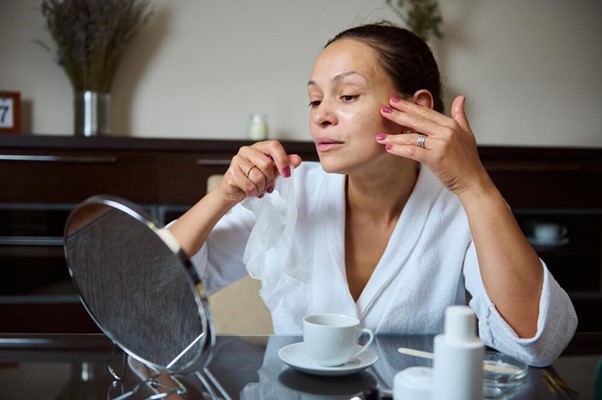
You’ve committed to a new skincare routine. Maybe it’s a prescription product like the Q-Stick. Maybe it’s your first time using actives like retinol or acids. You expected a glow, but your skin had other plans.
Redness. Flaking. A breakout that feels worse than before.
If this sounds familiar, don’t panic. It’s incredibly common, and it doesn’t mean your skincare has failed. In fact, it might be a sign that change is already happening.
Here’s why your skin might look worse before it gets better and how to support it through this phase.
Why Your Skin Might React to a New Routine
New active ingredients can speed up skin cell turnover or affect oil production, triggering changes on the surface. This can show up as flaking, dryness, or more blemishes than usual.
It’s often called the adjustment phase: a short period where your skin is working hard to renew itself.
When your skin suddenly starts to purge or peel, it can be discouraging. But this is often a temporary sign that your products are doing their job. Your skin is clearing out what’s been hiding under the surface.
Purging vs Irritation: What’s the Difference?
Purging happens when an active speeds up skin renewal. You might see breakouts in areas where you normally get spots, especially with ingredients like tretinoin or azelaic acid.
Irritation is different. It often involves redness, stinging, or flaking in areas that aren’t breakout-prone. If your skin feels sore, itchy or hot, it might be time to scale back.
Signs It Might Be Purging
- Breakouts are in familiar zones
- Skin feels a bit dry or tight, but not painful
- It started a few days after beginning actives
- It improves after 2 to 4 weeks
Signs It Might Be Irritation
- Breakouts appear in new areas
- Skin feels inflamed, sore or raw
- It gets worse over time, not better
- You’re using multiple new products at once
How to Support Your Skin Through It
1. Keep It Simple
When your skin is adjusting, less is more. Stick to a gentle routine: cleanse, treat, moisturise, protect. Avoid harsh scrubs or layering too many actives.
2. Use a Gentle Cleanser
The MiQuest cleanser helps prep the skin without stripping it. It removes dirt, sweat, oil and dead skin cells while keeping the skin barrier intact. A clean surface means your actives can do their job without interference.
3. Rehydrate With Moisturiser
Flaking and dryness are common during active treatments. A good moisturiser will calm irritation, hydrate deeply and help the skin absorb ingredients more effectively. The MiQuest moisturiser also supports your skin’s pH and reduces sensitivity to prescription actives.
4. Always Wear SPF
Sun protection is crucial, especially when using resurfacing actives. Fresh skin is more vulnerable to UV damage, which can undo your progress. The MiQuest SPF is designed to protect both your skin and the ingredients you’re using, preventing breakdown from sunlight and reducing redness.
What Not to Do
- Don’t introduce too many products at once
- Don’t scrub at peeling or flaking skin
- Don’t use new exfoliants unless your prescriber advises it
- Don’t quit your routine after one or two bad days

How Long Should You Give It?
Every skin journey is different. But here’s a rough timeline:
- Mild purging or flaking: 2 to 4 weeks
- Visible improvement in acne or texture: 6 to 12 weeks
- Pigmentation reduction: 8 to 16 weeks
If things don’t improve by then, or symptoms get worse, speak to your skincare provider. If you’re using MiQuest, our team is here to review and adjust your plan.
Some users of MiQuest, when starting their prescription acne face cream or prescription pigmentation cream, can feel disheartened if their skin becomes dry, flaky or red in the early weeks, but this is a common and temporary response.
Final Thoughts: Trust the Process
It’s tough to see your skin struggle when you’re doing your best to help it. But this temporary discomfort often leads to long-term results.
Keep your routine consistent, support your skin with the right essentials, and be patient. If your skin feels overwhelmed, take a step back and simplify. You’re not alone in this, and you’re not doing anything wrong.
Progress doesn’t always look perfect, especially in the beginning. What matters is where your skin is headed, not how it looks right now. Contact the MiQuest team if you have any questions!
FAQs
1. Is it normal to break out when starting a new treatment?
Yes. This is often caused by purging and usually clears within a few weeks. If it gets worse or spreads to new areas, reduce usage or seek advice.
2. Should I keep using my products if my skin is peeling?
Mild peeling is common. Keep moisturising and protect your skin from the sun. If discomfort increases, reduce frequency and check in with your prescriber.
3. How often should I apply the cleanser and moisturiser?
Use both twice daily: morning and evening. This helps keep the skin barrier calm and clear while your treatment works.
4. Why is SPF important when using active skincare?
New skin cells are more sensitive to UV damage. SPF protects your progress, prevents irritation and ensures your actives aren’t broken down by sunlight.
5. How do I know if I’m overdoing it?
If your skin is stinging, tight, peeling in sheets or burning, you might be using too much or too often. Scale back and simplify.






AI-Empowered Dermatology, Personalised For You.






